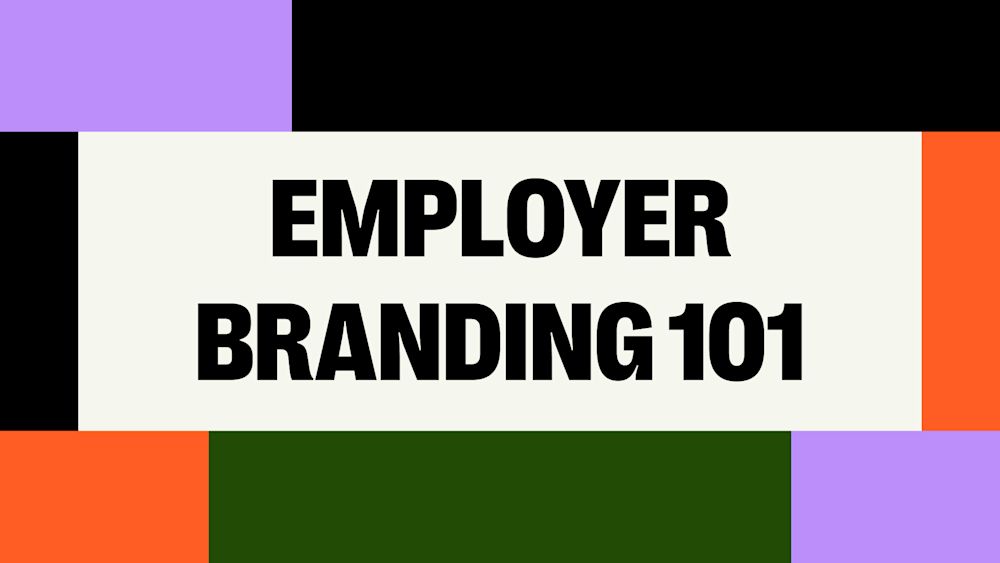- Iterate
- Employer Branding
- Employer Branding 101: How To Get It Right
Table of contents
In this guide, we’re covering what employer branding is, why it's important for companies of all shapes and sizes, and how to build a strong employer branding strategy.

Employer branding is all about how the general public perceives your company as an employer. How do job seekers and existing employees view you? The answer to that question defines your employer brand.
When it comes to attracting and converting the best talent for your open roles, keeping employees happy for longer, and cultivating a glowing reputation among the workforce, you won’t go far without a great employer brand and a strong employer branding strategy.
In this guide, we’ll cover:
- What is employer branding?
- The benefits of employer branding
- How to build an employer branding strategy
Let’s dive in.
What is employer branding?
Your employer brand is your reputation as a company — how people perceive your values and work environment. Employer branding is everything you’re doing as a company, intentionally or not, to promote your unique identity as an employer to both current and potential employees.
If people generally feel that you’re a good company to work for, you have a positive employer brand. If they don’t feel that way, your employer brand needs some attention.
Make no mistake: you have an employer brand, whether you’ve invested time and energy into building an employer branding strategy or not. Every company does. As long as you’ve been hiring and managing employees, you’ve been building your employer brand. It’s an inevitable part of being an employer.
The good news is that just by being aware of your employer brand and its importance, you’re already on the right track. The (potentially) bad news is that there’s no quick or one-size-fits-all way to establish your employer brand as the type of company anyone would want to work for — you have to truly become that company over time.
That means:
- Treating employees with respect
- Compensating workers fairly
- Cultivating a healthy company culture
- Providing employees with everything they need to do their job effectively
- Showing recognition for hard work and dedication when you see it
Even if you’re already doing all the right things to be an employer that anyone would want to work for, you still have to find a way to authentically get the word out. To that end, you can showcase what makes you a great employer through your:
- Careers page
- Public business profiles (e.g., Glassdoor and The Org)
- Social media accounts
- Job descriptions
- Employee-generated ratings and reviews
- Company mission and values statements
You may be thinking that this whole employer branding thing sounds like a lot of work. Is it really worth the trouble?
The short answer is a resounding yes. Building a great reputation for your company is one of the most worthwhile investments you can make. And no one — not even the employer branding experts — expects it to happen overnight. Employer branding is a long game that looks different at every org.
The benefits of employer branding
Employer branding has never been more critical for long-term growth. It’s like insurance for your employer reputation as you navigate any challenges that come your way — from the pandemic and new ways of working, to ongoing economic uncertainty and reputational fallout from layoffs.
Even if you’re not hiring right now for any combination of reasons, you will be one day — and your employer brand is a boon for peak recruiting efficiency as soon as you’re ready to get back out there.
Here’s a quick rundown of some of the many benefits of employer branding:
Employer branding helps you hire better employees
The most talented professionals know they have options. When choosing whether to continue the search or accept your offer, candidates will take your employer brand into account and weigh it against your competitors’ brands.
If your competitors are winning the employer branding game, they’re probably going to scoop up the top talent, too. The numbers back this up — studies have shown that:
- Companies with a strong employer brand receive applications from 50% more qualified candidates.
- 75% of job seekers are more likely to apply for a job if the company actively manages its employer brand.
- 92% of people would consider changing jobs if they received an offer from a company with an excellent reputation.
Want to learn more about employer branding in recruitment? Check out our article “Employer Branding in Recruitment.”
A positive employer brand reduces hiring costs
Employer branding also helps employers acquire talent more efficiently. In fact, one study found that companies with a positive employer brand can cut their recruitment costs in half and hire employees twice as fast.
That can make all the difference for a company hoping to scale quickly. By letting your employer brand do the heavy lifting during the candidate experience, you’ll have more resources freed up to invest in other growth initiatives.
Employer branding turns every employee into a brand advocate
When you give your employees a good work experience, you also give them a reason to sing your praise. This matters, because job seekers feel that an employee’s perspective on a company is three times more credible than the CEO’s.
With a team of employee brand ambassadors to support you, you can expect better testimonials on Glassdoor and other employer review sites, and more quality job candidates sourced through employee referrals — both of which will organically strengthen your employer brand over time.
Employer branding creates a structure of productivity
Attracting and retaining high-quality employees will inevitably boost productivity at your company — workers who are proud of their company are always more motivated and engaged in the long term, and have an easier time ramping up to full productivity out of the gate.
Employer branding can also reduce employee turnover by 28%. By retaining more of your staff, you can avoid the loss of productivity when onboarding new employees.
How to build an employer branding strategy
So far, we've established that the strength of your employer brand will impact the quality of your hires, the productivity of your existing staff, and the costs required to maintain a healthy employee base.
Now, let's dive into how you can build an employer branding strategy and shape your employer brand for the better:
- Conduct an employer brand audit
- Establish an employer value proposition
- Cultivate a healthy company culture
- Get the onboarding process right
- Set employees up for growth
- Make your people the voice of your employer brand
- Create a strong diversity and inclusion initiative
- Choose the right employer branding tools
- Study and take inspiration from the best
1. Conduct an employer brand audit
The first step towards a great employer branding strategy is evaluating your current reputation. How does the workforce feel about you now? You can audit your employer brand by:
- Reviewing major employer brand touchpoints like your careers page and social media profiles
- Surveying your current employees
- Reading employee testimonials
- Asking job candidates what they’ve heard about you
Using these insights, you can gauge the strength of your brand and spot opportunities for improvement.
Read more: “Measuring the Impact of Your Employer Brand”
2. Establish an employer value proposition
An employer value proposition (or EVP) is an overview of the ways your company provides value to employees. This includes:
- Salaries
- Benefits packages
- Office perks
- Job satisfaction
- Company culture
- Work-life balance
- Job security
- Company policies
Your EVP is your company’s answer to the question, “Why should I work for you?” That answer should guide your employer branding strategy.
Read more: “The Difference Between EVP and Employer Branding”
3. Cultivate a healthy company culture
Your company culture has a major impact on employee experience. Even if the pay is great, a toxic culture will always stifle job satisfaction. This makes cultivating a healthy company culture a crucial element in a strong employer branding strategy.
Help team members connect with their colleagues. Create channels for workers to share their concerns. Educate staff on how they should engage with each other and resolve conflict.
In short, let everyone know that their well-being is central to your business strategy — and take the necessary actions to back it up. When employees see that your actions match your words, they’ll be well on their way to becoming ambassadors for your employer brand.
Read more: “How an Org Chart Helps You Build a Better Company Culture”
4. Get the onboarding process right
First impressions are important. The onboarding stage is your opportunity to equip employees with the organizational knowledge they need to put their best foot forward — an essential part of creating a great employer brand and a strong employer branding strategy.
However, learning the ropes and getting acquainted with a new team and set of responsibilities all take time. Getting new hires excited about their roles is mission critical at this stage, and a transparent onboarding process with practical resources like a company org chart can help you do that.
Giving new joiners a visual layout of the whole company shows them how their role and team fit into the bigger picture. Without visibility into their impact early on in their employment with you, new joiners might find themselves unmotivated as soon as onboarding ends and the initial excitement of a new job wears off.
By offering new employees the support, context, and big picture vision they need to make an impact from the get go, you’ll see an uptick in your retention rate. You’ll also increase the odds that your staff will advocate for your employer brand down the line — and that’s an essential part of a great employer branding strategy.
Read more: “How Great Onboarding Improves Employee Retention”
5. Set employees up for growth
Talented workers want a fulfilling career. That means employers must help them develop their skills and advance their careers in order to earn their loyalty. According to a Pew Research Center study, lack of advancement opportunities is tied with low pay as the number one reason employees leave their jobs.
By showing job candidates how your company will help them achieve their long-term goals, you can give them a reason to join your team and stick around.
6. Make your people the voice of your employer brand
As you improve the employee experience at your company, you’ll have more good news to show off. Update your branding materials to reflect the great work you’ve done to become a better employer.
Remember to use employee-generated content, such as testimonials, as much as you can to add a healthy dose of social proof to your employer brand messaging.
At the end of the day, your current employees are the backbone of your employer brand. As part of your employer branding strategy, you should take every opportunity to let them show (not tell) why they chose you as their employer.
Read more: “Make or Break Factors in the Candidate Experience, and Your Employer Brand”
7. Create a strong diversity and inclusion initiative
A continuous commitment to diversity, inclusion, and belonging (DI&B) is a pillar of a strong employer brand. There are plenty of reasons for this, the most important one being that it ensures that all your employees feel like they belong and are seen, respected, and safe at work.
Another reason is that many candidates might be more inclined to apply to your company if they can see themselves in the people who already work for you. In fact, 3 out of 4 candidates say that when evaluating companies and job offers, a diverse workforce is an essential factor.
It’s also worth noting that, according to a McKinsey study, companies that are more diverse and inclusive are more profitable. In other words, if you want your employer branding strategy to be successful, DI&B should be one of of your top priorities.
8. Choose the right employer branding tools
We mentioned earlier that there is no one-size-fits-all approach to employer branding. The same goes for which tools to include in your employer branding strategy.
Employer branding tools can help you maximize your ability to attract, motivate, and retain both current and potential employees. Some tools are designed specifically for one area of employer branding, while others are more universal.
Some of the areas these tools can help you optimize are:
- Employee brand advocacy
- You career page
- Brand consistency
- Your social presence
Read more: 5 Top Best Employer Branding Tools 2023
9. Study and take inspiration from the best
The final step to building a strong employer branding strategy and a great employer brand is to learn from companies who are doing it right. Studying these companies and what they’re doing to build and promote their employer brand can inspire you to strengthen your strategy and take your own employer brand to the next level.
Some examples of brands who are doing employer branding right are:
- Canva — focus on transparency and accessibility through a full careers website dedicated to addressing top of mind considerations for job seekers
- Eventbrite — offers different work styles (hub office, flex, and remote), inviting employees to decide what’s best for them
- Google — highly attractive employee perks and benefits, as well as a focus on innovation and making a difference in the world
Employer branding supercharges hiring in every industry
In a rapidly changing talent acquisition landscape, the savviest companies are the ones who embrace change and take every opportunity to exceed the workforce's expectations.
Employer branding is quickly becoming the industry standard for hiring and retaining top talent, but make no mistake — it's so much more than a passing trend or buzzword.
Armed with these tips, you can get started on building your employer branding strategy, creating a great employer brand, and putting your company on the path to long-term growth.


The ORG helps
you hire great
candidates
Free to use – try today